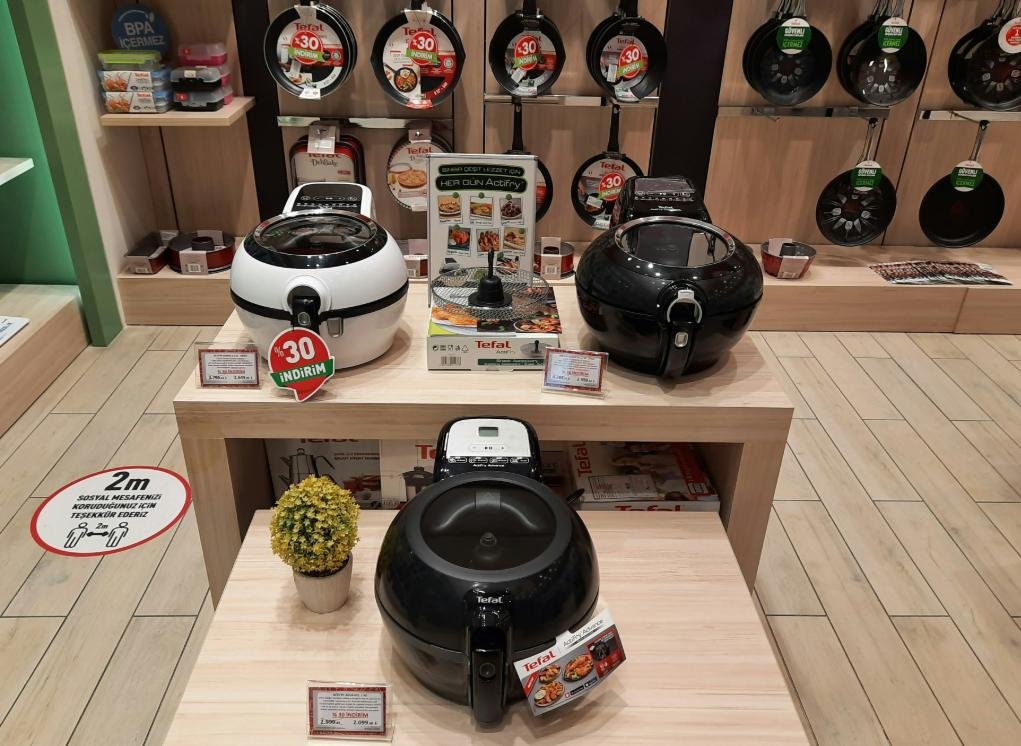Introduction to Frying Technologies
Frying technologies have significantly evolved over the years, leading to the introduction of various appliances that cater to health-conscious consumers. Among these innovations, oil-less fryers and air fryers stand out as popular alternatives to traditional deep frying methods. Each of these appliances utilizes distinct principles of cooking, primarily revolving around heat circulation and air flow to achieve crispiness without the need for excessive oil.
Air fryers operate on the principle of rapid air circulation. This technology involves a powerful fan that circulates hot air around the food, enabling it to cook evenly and attain a crispy outer layer—simulating the results of deep frying. The design of air fryers, which often includes a basket for easy removal and cleaning, allows food to be placed in a single layer to optimize the airflow, ensuring that each item receives sufficient heat exposure. This method significantly reduces the amount of oil needed, with many recipes only requiring a tablespoon or less, thus promoting a healthier cooking option.
On the other hand, oil-less fryers employ a unique approach that incorporates infrared heating and convection technology. Similar to air fryers, these appliances use hot air circulation; however, they also utilize infrared elements to provide additional heat. This dual heating method enhances cooking efficiency and enables browning without the use of oil. The result is food that can be cooked quickly while still delivering a desirable texture and flavor, akin to that achieved through traditional frying methods.
Understanding these frying technologies lays the foundation for a deeper exploration of how oil-less fryers and air fryers compare. By recognizing their operational principles, consumers can make informed decisions based on their cooking preferences and dietary needs. As culinary advancements continue, the analysis of these technologies becomes essential for any kitchen enthusiast looking to adopt healthier cooking practices.
Understanding Oil-less Fryers
Oil-less fryers are innovative kitchen appliances designed to produce crispy and delicious meals without the use of traditional cooking oils. They operate on the principle of circulating hot air at high speeds, which cooks food evenly, similar to the method of convection baking or air frying. This allows for a significantly reduced fat content in meals, making oil-less fryers an appealing option for health-conscious individuals.
The design of an oil-less fryer usually features a compact structure with an internal fan and heating mechanism. Once food is placed in the fryer basket, hot air is rapidly circulated, creating a crispy outer layer while keeping the inside moist and tender. As a result, a variety of foods such as vegetables, meats, and even baked goods can be prepared healthily without compromising on flavor or texture. The versatility of oil-less fryers extends to frozen foods, which can also be cooked without the need for preheating.
One of the most important distinctions between oil-less fryers and traditional frying methods is the absence of oil, which not only reduces calorie intake but also minimizes the health risks associated with high-fat diets. Traditional frying techniques often involve submerging food in hot oil, which can add unwanted fats and calories. In contrast, oil-less fryers produce a similar crunchy effect by utilizing hot air, thus offering a healthier alternative.
The cooking process in an oil-less fryer is generally simpler and cleaner than conventional frying since there is no oil to handle or dispose of. Regular maintenance usually involves cleaning the basket and other removable parts, making it a convenient choice for home cooks. This ease of use, combined with the health benefits, contributes to the increasing popularity of oil-less fryers among those looking to enjoy fried favorites without guilt.
Exploring Air Fryers
Air fryers are kitchen appliances that utilize innovative technology to cook food in a manner similar to frying, but with significantly less oil. The principle behind air frying involves the circulation of hot air around the food, allowing it to crisp up effectively while retaining moisture within. This technology is often referred to as rapid air circulation, which delivers even cooking results and enhances the flavor profile of the dishes prepared. As a result, air fryers have gained popularity among health-conscious individuals seeking to enjoy their favorite fried foods without the excessive fat content typically associated with traditional frying methods.
One of the primary advantages of air fryers is their health benefits. By reducing the amount of oil necessary for cooking, individuals can lower their calorie intake while still enjoying crispy textures that mimic those from deep-fried foods. This ability to produce healthier versions of favorites such as fries and chicken wings makes the air fryer an appealing option for families striving to maintain a balanced diet.
In addition to health advantages, air fryers are noted for their versatility. These appliances are not limited to frying; they can also bake, grill, and roast various types of food. This multifunctionality allows users to experiment with recipes, ranging from baked goods to grilled vegetables, making them an invaluable tool in the kitchen. Moreover, air fryers tend to be easy to operate, featuring straightforward controls and often coming with pre-set cooking programs that simplify the cooking process. This ease of use encourages individuals to explore various culinary creations, expanding their cooking repertoire.
To summarize, air fryers provide an effective and health-oriented alternative to traditional frying methods. Through advanced technology and versatile capabilities, they allow users to prepare crispy and delicious meals with minimal oil, making them an attractive addition to any modern kitchen.
Comparison of Cooking Methods
The comparison of cooking methods between oil-less fryers and air fryers reveals notable differences in temperature ranges, cooking times, and the overall quality of food produced by each appliance. Both appliances utilize hot air circulation to cook food, but they do so with distinctive approaches that affect the final dish. Typically, air fryers operate at higher temperatures, often ranging from 350°F to 400°F, which allows for quicker cooking times. On the other hand, oil-less fryers usually range between 300°F and 380°F. This difference in temperature can significantly influence how quickly food is cooked and its final texture.
When it comes to cooking times, air fryers tend to complete the cooking process faster than their oil-less counterparts. For instance, chicken wings may take about 25-30 minutes in an air fryer, whereas oil-less fryers can require up to 35-40 minutes to achieve a similar result. The ability of air fryers to reach and maintain higher temperatures contributes to this difference, making them more suitable for those who prioritize time efficiency in the kitchen.
The quality of food produced by both methods deserves attention. Air fryers are renowned for delivering crispier textures due to their rapid air circulation. Foods like French fries or onion rings often emerge from air fryers with a desirable crunch. Conversely, oil-less fryers may yield a softer texture, which could be beneficial for items like roasted vegetables or baked goods. A common example is the preparation of fish; air fryers achieve a flaky, crispy coat while oil-less fryers result in tender, moist fish. Therefore, the choice between an oil-less fryer and an air fryer may ultimately hinge on individual preferences related to taste and texture.
Health Benefits and Nutritional Aspects
In recent years, the popularity of oil-less fryers and air fryers has surged, largely due to their health benefits and the nutritional advantages they offer. Both appliances primarily focus on reducing the amount of oil used in cooking, which has significant implications for calorie and fat content in meals. Traditional frying methods often require substantial amounts of oil, leading to unhealthy, calorie-dense dishes. In contrast, oil-less fryers and air fryers utilize hot air circulation to cook food, allowing for the crispiness associated with frying while minimizing oil consumption.
By employing these modern cooking conveniences, users can expect a reduction of up to 80% in oil compared to conventional frying. This not only results in a lower calorie intake but also helps decrease unhealthy saturated fat levels in meals. By utilizing less oil, both appliances make it easier for individuals to manage their dietary fat consumption, which is crucial for anyone aiming for a healthier lifestyle.
Nutritionally, using oil-less fryers and air fryers provides additional benefits. The cooking methods employed in these appliances often preserve the vitamins and minerals in food better than traditional frying. Since they require less or no oil, essential nutrients remain intact, contributing to a more balanced diet. Furthermore, the reduced cooking time and lower temperatures associated with these appliances can also minimize nutrient loss, ensuring that meals are both delicious and nutritious.
Another noteworthy aspect is the potential for incorporating a variety of food items, including vegetables, lean meats, and whole grains, in a healthier manner. This adaptability allows users to explore diverse culinary options while sticking to nutritional goals. With the growing emphasis on health and well-being, opting for oil-less or air frying techniques can significantly contribute to a healthier diet and lifestyle.
Ease of Use and Maintenance
When evaluating kitchen appliances, especially those designed for frying, ease of use and maintenance are critical factors that influence user satisfaction. Both oil-less fryers and air fryers are marketed as convenient alternatives to traditional frying methods, but they differ in user experience and upkeep.
Air fryers are often designed with user-friendly interfaces that feature digital displays, preset cooking functions, and temperature controls. These features allow users to quickly set the desired cooking time and temperature with minimal effort. Oil-less fryers, on the other hand, can vary significantly in their design and functionality. Some models may have straightforward controls, while others might be more complex, requiring users to familiarize themselves with different settings and options. Thus, prospective buyers should consider their comfort levels with technology when selecting between the two appliances.
Cleaning is another important aspect when comparing these two types of fryers. Many air fryers come with detachable components that are dishwasher-safe, making cleanup relatively quick and easy. This facilitates maintenance, as users can simply place the removable parts in the dishwasher after use. Conversely, oil-less fryers may have components that are more challenging to clean. Depending on the model, users might need to scrub certain parts by hand, which can deter them from using the appliance regularly.
For maintenance, both appliances are relatively low-maintenance. However, air fryers may require occasional inspection of their heating elements and fans to ensure optimal performance. In contrast, oil-less fryers might need less frequent checks, but their simplicity can sometimes lead to users neglecting necessary maintenance tasks. In essence, both appliances offer unique benefits concerning ease of use and maintenance, which can play a pivotal role in determining which one is better suited for one’s lifestyle and cooking habits.
Cost Analysis
The cost of kitchen appliances is a significant factor that influences consumer decisions. When comparing oil-less fryers and air fryers, several financial aspects must be considered, including initial purchase prices, operational costs, and long-term value.
Initially, the price range for oil-less fryers tends to be lower than that of air fryers. Oil-less fryers, designed for performance using hot air circulation, typically start at a more affordable price point, while air fryers often feature advanced technology and functionalities, which can elevate their cost. However, prices vary based on brand, capacity, and additional features, so consumers should compare specific models to determine the best value for their needs.
Operational costs play an equally important role in the overall investment. Both oil-less fryers and air fryers consume electricity to function, but the energy efficiency can vary between models. Generally, air fryers are known to operate quickly and efficiently, often using less energy than conventional ovens, which may lead to lower electricity bills over time. In contrast, oil-less fryers may consume slightly more energy due to longer cooking times. Consumers should check the wattage of each appliance, as higher wattage generally translates to higher energy consumption. Understanding these metrics can aid buyers in forecasting their ongoing operational expenses.
When considering long-term value, it is essential to assess durability, warranty, and performance over time. A more expensive air fryer might offer superior longevity and versatile cooking capabilities, potentially justifying the initial higher investment. In contrast, while oil-less fryers may price lower upfront, their lifespan and functionality may not align with consumer expectations. Consequently, analyzing the varying costs associated with both oil-less fryers and air fryers is crucial for informed purchasing decisions. By weighing initial expenses against ongoing costs and potential long-term satisfaction, consumers can select an appliance that best fits their budget and culinary preferences.
Customer Experiences and Reviews
The surge in the popularity of oil-less fryers, commonly known as air fryers, has attracted myriad experiences and reviews from customers eager to share their cooking journeys. Many users highlight the convenience and efficiency of these innovative appliances, often citing the health benefits of reducing oil intake without sacrificing taste. For example, one user praised their air fryer for its ability to cook crispy French fries with significantly less oil, describing it as a “game changer” for family meals and gatherings.
However, not all experiences are uniformly positive. Some customers have faced challenges with cooking times and food consistency. A recurring theme in testimonials is the learning curve associated with air frying. Users have documented initial difficulties in determining the ideal cooking times and temperatures, noting that certain foods required several adjustments before achieving the desired results. One user mentioned, “I initially overcooked my chicken wings, but once I figured out my air fryer’s settings, they turned out perfectly crispy and tender.” This illustrates how personal adjustments play a crucial role in the successful use of oil-less fryers.
Additionally, customer reviews frequently underscore the versatility of air fryers, with many users experimenting with a diverse range of dishes from vegetables to desserts. One enthusiastic reviewer shared their success in baking a cake, emphasizing the air fryer’s ability to create a moist interior while maintaining a golden crust. This adaptability appeals to aspiring chefs who are eager to try new recipes and cooking techniques.
Overall, the feedback from customers using oil-less fryers and air fryers reflects a mixture of satisfaction and challenges. While many enjoy the health benefits and ease of use, others recommend patience and creativity to master the appliance. User reviews prove invaluable for prospective buyers, as these real-life experiences can significantly aid in making informed purchasing decisions.
Conclusion: Which One Should You Choose?
As we have explored throughout this blog post, both oil-less fryers and air fryers offer unique benefits and drawbacks that cater to different cooking preferences and health objectives. Oil-less fryers utilize advanced technology to achieve crispiness without the need for traditional frying oils, making them an excellent option for those focusing on health-conscious cooking. Air fryers, on the other hand, provide similar results while allowing for versatility in meal preparation, enabling users to bake, grill, and roast in addition to frying.
When deciding which appliance to choose, one must consider various factors including cooking habits, health goals, and budget. Individuals looking for a simple and efficient way to enjoy fried foods without the guilt may lean towards an oil-less fryer. These devices generally require less maintenance and offer straightforward functionality, making them suitable for busy individuals or families with children. Furthermore, they often come at a lower price point, making them a more budget-friendly choice for occasional cooks.
Ultimately, the decision should align with your cooking style, dietary aspirations, and financial considerations. By evaluating these aspects, consumers can make an informed choice between an oil-less fryer and an air fryer, ensuring their new kitchen appliance effectively meets their culinary needs.






